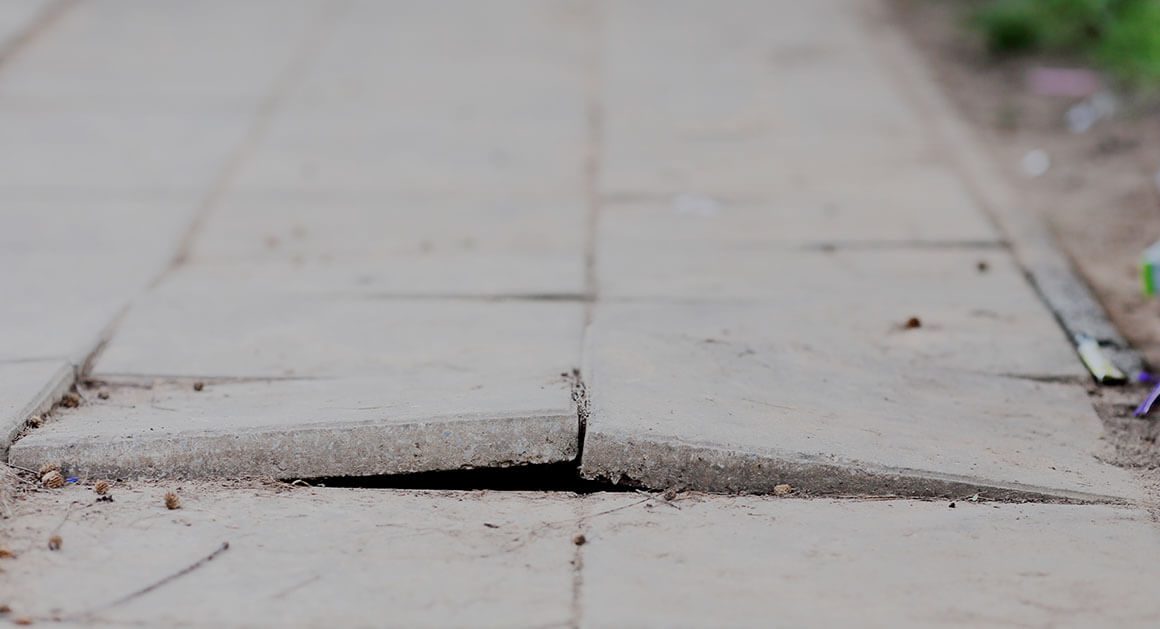You or a loved one has fallen on a sidewalk in New York City. The crack which caused the trip and fall was significant in size. By the look, size, texture and color of the crack it appeared to have been there for a long time.
Determining legal liability may not be as simple as you think.
Your consultation with a lawyer will likely start out with the attorney asking many questions. You will sense the reason for some of the inquiry. Where were you looking when your tripped? Were you on the cell phone – texting or otherwise distracted? These questions relate to the potential degree of your own fault. Such inquiry is for obvious purpose.
But other questions will be directed to another central issue in a trip and fall case – who, if anyone, is legally answerable for the poorly maintained sidewalk?
The New York Administrative Code (Section 7-210, effective on September 14, 2003 and therefore applicable since that date) provides the following:
“a. It shall be the duty of the owner of real property abutting any sidewalk, including, but not limited to, the intersection quadrant for corner property, to maintain such sidewalk in a reasonably safe condition.
b.Notwithstanding any other provision of law, the owner of real property abutting any sidewalk, including but not limited to the intersection quadrant for the corner property, shall be liable for any injury to property or personal injury, including death, proximately caused by the failure of such owner to maintain such sidewalk in a reasonably safe condition.”
The duty of the abutting property owner includes the “failure to install, construct, reconstruct, repave, repair, or replace a defective sidewalk”. It also includes the failure to timely remove – or the negligent removal of—snow, ice, dirt, or other material from the sidewalk.
Seems straight forward. But the exceptions to the rule are very significant.
In the wisdom of the New York City Council there was an exception built into the law.
The adjacent property owner is liable (rather than the City of New York who may be liable in certain limited circumstances) unless the abutting property is a one, two or three family residence that is in whole or in part 1) owner occupied; and, importantly, 2) used exclusively for residential purposes.[1]
In such limited cases, the property owner may not be liable for the defective sidewalk that caused your fall.[2] Instead, the potential responsible party will likely be The City of New York. But again, this is not quite so simple. There are various legal issues which may come into play.
A case against the City of New York may present additional legal hurdles to overcome.
First, a claim against a municipality such as the City of New York must normally be filed within 90 days of the accrual of the cause of action (accrual is a legal term of art, which in this case is the date of the trip and fall) while a claim against a private property owner (not a municipal owner such as NYCHA which also has a 90 day Notice of Claim requirement) normally has a statute of limitations of three (3) years from the date of the accident[3].
Second, the City of New York has a unique notice requirement which is mandated by law. A claimant must allege and prove that the City of New York received prior written notice of the condition which caused the claimant to trip and fall. This is not required of a private property owner. Upon proper analysis this may result in a conclusion that recovery may be difficult or impossible depending upon whether the City received such prior written notice.[4]
The importance of the residential use exception is therefore not to be understated.[5]
An analysis must include whether the private property owner is entitled to the residential use exception.
At first glance, the terms of the statute reserves the residential use exception to premises that are used exclusively as owner occupied 1, 2 or 3 family buildings.
The use of the word “exclusive” should mean what it says. In fact, cases have interpreted the term “exclusive” in what some may consider a counterintuitive way.
In Coogan v. City of New York, 73 AD3d 613 (1st Dept 2010), the Appellate Division of the Supreme Court, First Department addressed the definition of the term.
In the Coogan case, the court held that an owner’s use of his laptop computer for occasional research in the premises was “merely incidental” to his residential use of the property and, therefore, the residential use exception applied. The court examined the legislative history of the section noting that the exception for exclusive residential use was designed to “recognize the inappropriateness of exposing small-property owners in residence, who have limited resources, to exclusive liability with respect to sidewalk maintenance and repair.”
In the words of the court (emphasis supplied):
“There is no reason to extend the statute’s reach to encompass this defendant. Generally, a legislative enactment that is unambiguous and whose purpose is unequivocal should be construed in accordance with the ordinary meaning of its words, and literal and narrow interpretations that would thwart such purpose should be avoided.”
The Coogan court dismissed the case against the residential property owner. The residential use exception stood despite the fact that the property was not being used “exclusively” for residential purposes.
Compare that holding with the Supreme Court, New York County’s holding in Sisler v. The City of New York, 2010 WL 5068882 (Sup Ct, New York County 2010). In Sisler, the court held that the residential exception would not apply to the home owner when the home was used in a more substantial commercially devoted manner.
In the Sisler case the homeowner had an employee present for commercial duties 3 days a week. The owner performed administrative and design tasks and basically orchestrated her business from her home. The court held that the commercial work performed in her home was “neither occasional nor incidental”. The private property owner was held legally answerable for any negligent maintenance.
The occasional or incidental test may be a bit difficult or challenging to define absent litigation. For this reason, many lawyers are compelled to name both the residential property owner and the City of New York when the gravity of the commercial use is unclear or subject to debate. The doubt caused by a sliding gravity scale definition of the word exclusive necessarily results in litigation. The discovery process is then utilized to distill all the salient facts which may be used by the court to determine whether the commercial use is deemed “occasional or incidental”’.
So as with many things, the devil is in the details. Limited use of a residence for commercial pursuits will not typically cause the resident private property owner to lose the residential use exception. Investigation as to the specifics of the extent of use is required in order to determine the ultimate answer to who, if anyone, may be liable for the sidewalk defect which caused your fall.
[1] emphasis added
[2] There are exceptions to this rule as well.
[3] There may be exceptions to this rule as well under the tolling statutes and various other potential fact patterns.
[4] Or may fall under a few other exceptions to the rule which are beyond the scope of this article.
[5] Of course, with every rule may come various exceptions which can, in the correct case and circumstances, save a claim even if the 90-day filing is missed. The scope of these exceptions is beyond the scope of this short article. It is essential that a lawyer be consulted in order to explore all issues related to municipal liability.
We welcome your legal questions for topically relevant articles in the future. Feel free to compose a question – it may be addressed in future articles. Email Question
Free Case Evaluation
Fill Out The Form Below To Find Out If You Have A Case.
Thank you for contacting us. One of our colleagues will get back to you shortly.



